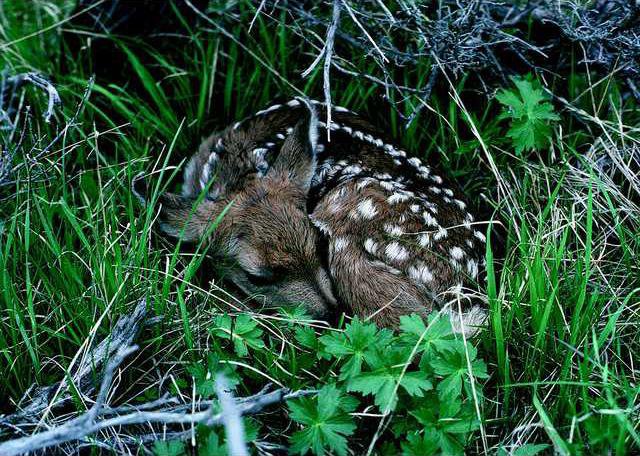The staff at nature centers, zoos, state agencies, and anyone else who works with wildlife knows that there’s another sign of spring besides chirping birds and blooming flowers. It’s the phone calls from helpful and caring members of the public who’ve found an animal that they’re concerned about. Spring is the time of year when young critters are being born, growing up, and of course, getting into trouble. But sometimes what looks like trouble to us humans is just another stage of life for a wild animal.
Baby birds have it pretty rough – many species hatch completely helpless. No feathers, blind, and completely dependent on their parents. They do grow up, though! Fledging is an essential stage in a baby bird’s life. Once it’s grown large enough and grown its flight feathers, it’s ready to leave the nest. For the baby though, leaving the nest is scary! They can be so hesitant to leave the nest that their parents actually shove them overboard. (I’m sure some parents of teenagers are feeling great sympathy for these parent birds right now.) Then the youngster is out of the nest and on the ground. The parents are still watching over it and helping it to find food, but it’s made an important step in its life. This is a natural stage of life that looks very much like the baby is in trouble to a helpful human who comes along. Rest assured though – if you find a young bird on the ground that has most of its feathers, it’s just fine! As long as it’s not in danger from neighborhood cats or folks mowing lawns, the little bird will be alright. If it is in a hazardous place, you can move it somewhere more out of the way.
Another bunch of youngsters that often looks like they’re in trouble to humans are baby bunnies. Many times a homeowner will be out working in their yard and find a whole bunch of tiny baby bunnies that have been left all alone. To us, this looks like the poor things have been abandoned! But really, it’s just how rabbits care for their babies – the mother visits her babies once or twice a day to feed them, and then leaves them hidden to avoid leading predators to her young. What looks like abandonment to us is really just a smart strategy for the rabbits. The best thing that you can do is just leave the little guys alone! Try not to mess with the nest any more, and if you can avoid mowing or weed-eating around it, that’s even better. If you’re really concerned about the babies, you can watch the nest to see if the mother comes back, or lay a few strings on the ground around it and see if they’re disturbed. If they’re moved, mama bunny has been coming to check on her babies still.
Just like rabbits, mother deer hide their babies to avoid attracting predators to them. The fawns are spotted so that they blend in well with the grass, and they instinctually sit very still while mom is gone. Many people are very concerned when they find a fawn all alone, and it does seem scary to us! Humans can’t imagine leaving our babies all by themselves for hours at a time, but it’s completely normal for these critters. By leaving her baby alone and hidden, the mama deer can find food for herself without worrying if her baby will be able to keep up if she needs to run from a predator. If you find a fawn, just like with the baby rabbits, the best thing you can do is leave it alone.
So what happens when someone doesn’t realize that the best thing they can do for baby animals is to leave them alone? It depends on the situation. Many times the best thing to do is to take the baby back to where you found it. The old wives tale that the parents will reject the baby once a human has touched it is just that, a tale. Put the baby back as close to where you found it as possible, and the parents will find it and continue caring for it.
Sometimes an animal really is in trouble. In cases where bird nest is destroyed before the babies are ready to fledge, the youngsters do need help to survive. If you find a baby bunny or a fawn that is actually injured, the little guy does need a human’s help. In all these cases, the best thing to do is contact someone trained in caring for wildlife. Wildlife Rehabilitators have special training and tools that the rest of us lack, and they have the necessary permits to handle and keep wild animals. Not only is it illegal for people without these permits to try to care for injured wildlife, if you don’t have the training and experience you’ll do more harm than good! The Kansas Department of Wildlife, Parks, and Tourism has lots more great information on Wildlife Rehabilitation available on their website - http://ksoutdoors.com/Services/Rehabilitation
Baby animals are one of spring’s best features – they’re fun to watch, exciting to see grow up, and show us a little hope for the future. We do need to be aware that they aren’t human, and they don’t face the same issues that we do. The best thing that we can do for wildlife is to leave them alone and let them live as nature intends! If you have questions about young animals you’ve seen, or need help finding a Wildlife Rehabilitator for an injured animal, we’re always glad to help here at the Kansas Wetlands Education Center! You can give us a call at 1-877-243-9268 seven days a week. We’re open from 9-5 Monday through Saturday, and 1-5 on Sundays. Enjoy all of spring’s excitement, and remember to keep an eye out for those cute baby critters!
Wetland Explorer: Wildlife Rescue?





